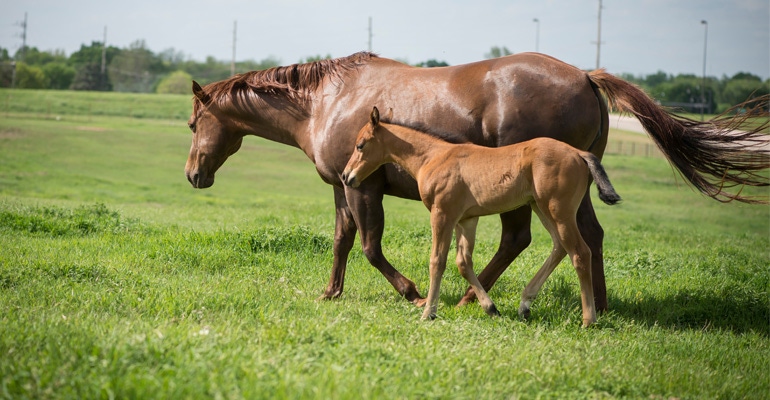
Excessive summertime heat has rolled into Oklahoma, making it paramount that equine owners optimize their horse’s water intake to ensure animal well-being and performance.
“Ensuring a horse consumes adequate water is not always easy given how the animal’s water needs can vary greatly according to diet, temperature and amount of exercise,” said Kris Hiney, Oklahoma State University Cooperative Extension equine specialist.
First of all, consider the manner in which water is provided to the horse. Modern management systems are quite different from where a horse naturally would drink water, such as streams, ponds and the like. Automatic systems may be massive time-savers for horse managers but what do the animals actually prefer?
“Many horse managers acknowledge that horses enjoy drinking from buckets far more than automatic water systems, and this has actually been borne out in the scientific literature,” Hiney said. “Given a choice, horses prefer buckets over automatic waterers almost exclusively.”
Furthermore, the type of water-provider also may influence a horse’s drinking behavior. In a study of horses never exposed to automatic waterers, the animals preferred float valve waterers compared to push valves. Push-valve waterers are those in which a horse must use some force of its muzzle against the valve.
“In that study, horses never consumed water from the push valves,” Hiney said. “It was believed the larger available reservoir of water in the float-valve waterers encouraged the horses to drink more.”
In addition, push valves have a somewhat startling effect of the noise of water refilling the waterer. Horses were reluctant to return to the waterer after being startled.
“To make things even trickier, the normal intake rate of water by a horse actually exceeds the flow rate of most waterers,” Hiney said. “Therefore a horse would need to drink much more often when using a low-flow waterer. This may actually cause the horse to reduce its intake compared to being offered water in a bucket.”
Hiney added this does not mean automatic waters should not be used, but when selecting a waterer, look for one that maintains a larger reservoir of water or has a larger surface area. Try to find a quiet waterer as well.
“Horses can learn to use push-valve waterers but, during the training period, careful observation should be employed to prevent animal dehydration,” she said. “It also may be helpful to install a monitoring system in the pipeline feeding the waterer so that water consumption can be monitored.”
Adjust for travel
Traveling with horses also is a key time to closely monitor water intake, especially during long trips. Horses may reduce water intake for a number of reasons. Stress, unfamiliar flavors of water, reduced feed intake and increased water losses may all create a state of dehydration.
“Often during travel horses will reduce their feed intake, which subsequently reduces water intake,” Hiney said. “Reduction of water intake may lead to dehydration as horses typically increase water losses through sweating while trailering.”
In addition, equine owners need to consider how much muscular work a horse must perform to balance long trips. Reduction of water availability may decrease a horse’s desire to eat as well.
“It’s important to break this cycle of reduced feed and water intake to ensure a healthy, happy horse when it reaches its final destination,” Hiney said.
Since a horse may be reluctant to consume water which has an unfamiliar flavor, the addition of a flavoring agent can get the horse accustomed to a unique flavor that can mask new tastes. However, Hiney recommends any introduction of a flavoring agent be done at home prior to the trip. Horses accept new flavors more readily when they are not stressed and are in a familiar environment.
“Use a training period prior to travel so that you do not discourage your horse from drinking,” she said. “In a test between apple and clover flavors, horses clearly preferred to drink apple-flavored water. There are multiple products available so choose one your horse likes.”
And remember, horses also drink when they eat, so it is important to offer water simultaneously. Many equine enthusiasts know some horses prefer dipping their hay in water. Hiney explains this is a normal behavior and need not be discouraged.
“While it may be messy, horses sometimes do this to moisten dry feed and make it easier to chew,” she said. “Relatively recent studies have shown horses consumed their hay much faster when it had been previously soaked. Presumably this was due to the ease of chewing of the soaked hay. This strategy may be helpful for horses that have dental issues.”
Some studies have suggested that chopping hay may encourage water intake or change water dynamics in the hindgut during long-term exercise. However, water intake in Arabians fed either long stem hay or chopped hay did not differ, nor did the moisture percentage in the feces.
“Ultimately the total amount of forage consumed will directly influence water intake,” Hiney said. “Also, like humans, horses are sensitive to the temperature of their water.”
In research studying horses completing work which created both dehydration and an elevation in temperature, the animals initially preferred a saline solution that was 50 degrees Fahrenheit compared to lukewarm or warm saline solutions. However, after about 20 minutes, the horses preferred the lukewarm liquid.
“Presumably horses prefer cooler fluids in order to help with thermoregulation,” Hiney said. “The bottom line is to provide ready access to a source of water the horse prefers. Awareness of these simple strategies can help ensure that your horse is always well hydrated.”
The Oklahoma Cooperative Extension Service is one of two state agencies administered by OSU’s Division of Agricultural Sciences and Natural Resources, and is a key part of the university’s state and federally mandated teaching, research and Extension land-grant mission.
About the Author(s)
You May Also Like




